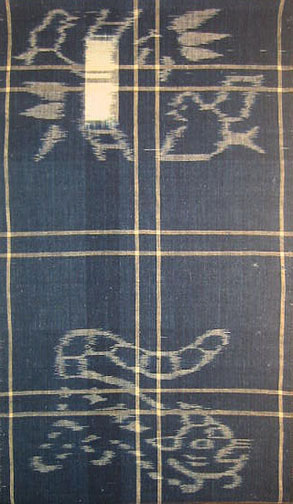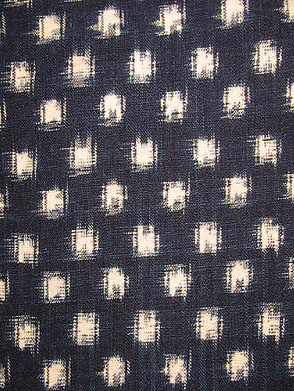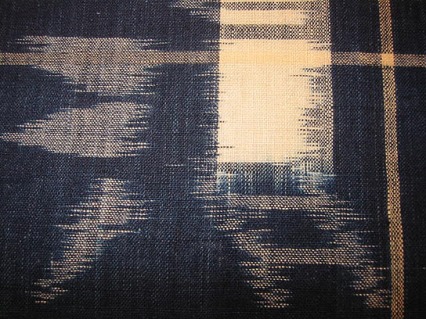“Ikat” is an Indonesian word for the technique of resist-dyeing threads before weaving them in order to create a patterned fabric.
This week I am focusing on traditional Japanese ikats that are known as “kasuri.”
I learned about these remarkable textiles from Yasuko Tada, a Japanese woman we met years ago who imported Japanese folk art that she sold to museum shops. She was knowledgeable about the Japanese mingei movement (which I had never heard of), and her collections were always first-quality traditional handcrafts, not tchotchkas. We spent some very happy hours sitting in her apartment admiring the work. We bought as many textiles, ceramics, and other goodies as our limited budget allowed, including about a dozen pieces of kasuri and e-gasuri, which are Japanese picture kasuri, like the textile shown at the top of this page.
Harold B. Burnham, textile scholar, author of “Japanese Country Textiles” (Royal Ontario Museum, 1965), and my source for much of the information in this article, divides kasuri into three groups depending on their pattern and scale: splashed kasuri, like the geometric design (from one of my jackets) shown below
small-patterned kasuri,
and e-gasuri. The first two types of designs are used for clothing, while e-gasuri is used for futon covers and curtains. It is always woven with white motifs on an indigo blue ground.
Kasuri textiles can have warp-dyed threads, weft-dyed threads, or areas of both in the same cloth. It takes great skill and patience to measure, stretch, and tie the threads for warp ikat, even more skill to dye weft threads (because they don’t usually get stretched and measured before being wound on bobbins), and still more extraordinary skill to prepare the double ikat yarns precisely enough for them to meet exactly where they should when they are woven, as in the window below.
After tying, dyeing, and unwrapping the threads — preparation that can sometimes take a year or more — the cloth itself is woven in tabby. All of these designs are traditional and have been reproduced exactly the same way in families and in villages for hundreds of years.
But today the extraordinarily time-consuming art of hand-tying ikat has largely been replaced in Japan by printing, painting, and stamping the yarns, except for some exceptionally fine kimonos, and the work of international contemporary fiber artists such as Yoshiko Wada.
Many kasuri motifs express messages of good luck, longevity, etc. Bamboo leaves symbolize resilience, and when they are combined with sparrows and tigers, as they are in the piece at the top of this post, are said to symbolize happiness.
In future posts I will write about other e-gasuri pieces from my collection depicting cherry blossoms, cranes, turtles, Darumas, and castles, but of course I had to start off with, well, a cat image.




Interesting to read about ikat. (And yes – I noticed that you had a cat in the picture…..I was a little happier when I read that it is a tiger!!)
I recently saw an exhibit at the Hood Museum at Dartmouth that had very fine ikat from Indonesia. I was amazed at the intricate patterns they were able to produce. Your post reminded me again of all that goes into ikat fabrics.
Thanks for sharing!
Sue
Thanks for your comment, Sue. I only did a very simple warp ikat once and that experience was enough to convince me to be an admirer of ikat, not a creator.
I do love Japanese textiles and these are beautiful, definitely not “tchotchkas.” I enjoyed reading what you wrote about e-gasuri and would like to see more from your collection.
Eva